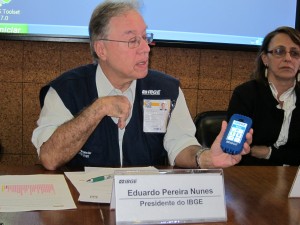Brazil goes all-digital with 2010 census

Last week, I was in Brazil on a media tour sponsored by Apex-Brasil, a government agency with a mission to attract foreign investment and support the nation's international business interests. The trip focused on the country’s 2010 Census and included meetings with executives from the Brazilian Institute for Geography and Statistics (IBGE) along with senior government officials. What follows is a look at the system specs.
Better known for its beaches and passion for soccer, Brazil also happens to be the world's second-leading open source country (just behind the U.S.) and boasts an IT services sector that rivals China and India. The South American country is now putting its digital leadership on display by carrying out its first-ever paperless, all-digital population census.
The success of the undertaking is a matter of national pride as it is instrumental for social policy. It's being led by IBGE - think U.S. Census Bureau, National Geospatial Program, and National Geodetic Survey all rolled into one. The expected budget for Brazil's 2010 census is $900 million USD.
From August 1st through October 31st, 58 million households and 5,565 municipalities will be surveyed by 240,000 hired hands. Armed with 225,000 PDAs and notebooks equipped with GPS receivers, the survey takers will traverse over 8.5 million kilometers squared, including remote parts across the Amazon, to learn about Brazil's 194 million people than ever before.
"Our census has a very big questionnaire, probably the largest in the world," said IBGE President Eduardo Pereira Nunes.
Brazil also provides the option of filling out the census questionnaire via the internet, but it requires a hand-delivered code to access the questionnaire on the secure website.
The advantages of going digital is mainly speed. In the first 15 days of data collection, they managed to count 17% of all households, trouncing the original goal of 9%.
Data gathered in the field is transmitted instantaneously from IBGE's 7,000 collection facilities throughout the nation. The new census approach allows for greater comprehensiveness and reach, according to officials. With just a PDA to lug around, census takers can get into rural areas more easily. They utilize any means of transportation that the environment calls for including SUVs, boats, motorcycles, and even mules. In this way, more minorities such as indigenous communities living in rural areas are counted. Not to mention the environmental and cost benefit of avoiding the use of paper.
According to IBGE, roughly 150,000 of the PDAs are LG devices (model LM750Q) that have been stripped of all communication applications at the factory and customized for the census. These were purchased for about $300 USD each. The other 75,000 PDAs are the larger MIO 550B models from Japan, which were previously purchased in 2007 during the testing phase of the system.
IBGE is a Microsoft shop, so the LG PDAs use Windows Mobile 6.5 and the MIO PDAs use Windows Mobile 5.0.
In a demo of the system given at a collection facility in Rio's famous Barra da Tijuca neighborhood, the survey data was transferred via USB from the PDA to the laptop in a few minutes. The device retains an encrypted backup and a copy is sent to the database. Answers are saved before proceeding questions appear.
Each municipality across Brazil has at least one laptop for data transferring from the PDAs, but medium and large-sized municipalities may have more than one. The laptops total about 8,400. An additional 1,300 computers and printers run the "sub-area departments" which are a group of municipalities in each state, or part of a large municipality.
The census data is transmitted from these collection facilities to servers at the IBGE Data Processing Center in Rio de Janeiro. This is the central system that houses a data-warehouse containing over 2 billion lines of information.
There's about $67 million USD in storage devices, routers, switches and other hardware. 2,000 out of the existing 7,000 data collection posts are connected through ADSL modems; 500 are connected through 2G/3G mini-modems and 300 are connected through mobile satellite. There's also 40,000 2GB USB drives for data transfer of those data collection posts which are not connected.
As for networking, IBGE relies on two OC3 155-megabit links, available exclusively to the census data reception. One of them is open to receive all questionnaires that will be answered by the internet and the other receives data from the collection posts for 27 states and the "sub-area departments" in Sa?o Paulo, Minas Gerais, Rio Grande do Sul and Bahia states.
All applications used in PDAs, collection posts, Supervision and Assessment surveys have been developed by IBGE. The collection post application has been developed in a TotalCross open-source platform.
The goal of the digital census is for Brazil to get a better sense of the racial, economic, and demographic makeup of its diverse people. The results will be used for public and private planning for the next 10 years, principally to determine how to allocate federal funding for local governments.
